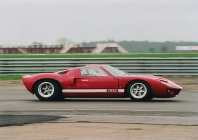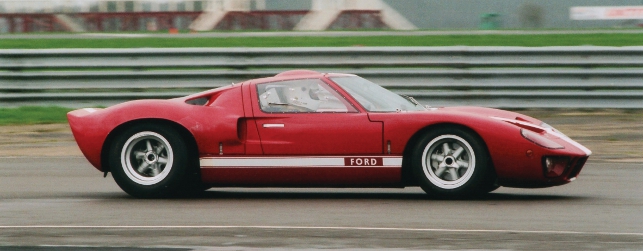Fast cars play a big part in Brian Coombs’s life. Not only is he the engineering lead for mechanical design at Bloodhound SSC, the UK’s project to retain the World Land Speed Record with a jet and rocket-powered 1,000mph car, in his spare time he is rebuilding a replica of the classic Ford GT40 sports car.

What Brian Coombs hopes his Ford GT40 replica will look like once complete
First launched in 1963, the car packs quite a punch with its tuned, five litre V8 engine, however the gearbox in Coombs’s replica has a tendency to fail under the power it has to handle.
“A suitable replacement gearbox is very expensive. So as part of the project to rebuild the car and at the same time upgrade some of the engineering aspects of it, so it is better able to handle the power, I decided to build my own gearbox using the internal parts that I had from of an old Reynard Indy racing car,” explains Coombs.
Having set up a machine shop at his home in Ireland and with access to Siemens NX software, he set about creating a CAD model from which new parts could be manufactured.
However, the gearbox design presented something of a challenge. How was he going to ensure that the redesigned gearbox would fit into the available space in the car’s engine bay and that it would align correctly with the car’s other components?
He could build a physical mock-up, manoeuvre it into place manually and take the measurements needed. But this would be very time-consuming.
The answer came from the UK office of 3D scanner manufacturer, Solutionix. Using one of its Rexcan scanners, the gearbox casing could be scanned and then Geomagic Studio 3D imaging and reverse engineering software used to create an accurate 3D digital model of it from the scan data.
This model could then be utilised for ‘volume claim’ packaging purposes in Coombs’s CAD system.
3D scanning
The 3D scanning process began with a Rexcan 420 structured light 3D scanner to capture the shape of the gearbox casing.
It was used in conjunction with a Solutionix automatic turntable, which can handle items weighing up to 70kg. With the gearbox casing mounted on the turntable, the scanner was set up to look down on it at 45 degrees.
With Solutionix ezScan software controlling and coordinating the turntable’s motion and the scanner’s data capture processes, scans of the upper half of the casing were taken automatically at increments of ten degrees as the turntable rotated through 360 degrees.
The casing was then turned over and the process repeated in order to capture the lower half.
In all, 72 individual scans were taken in a session lasting about an hour. Using the Solutionix ezScan software, these individual scans were registered with each other automatically as the scanning was proceeding to create a single 3D point cloud model of the gearbox casing.
This was then converted by the scanning software into a single, merged polygon model.
3D surface model
The next step was to convert the polygon model into an accurate 3D digital surface model suitable for use in the CAD system.
For this it was exported from the Solutionix scanning system into Geomagic Studio 3D imaging and reverse engineering software.
Firstly, the polygon model had to be repaired. So, using Geomagic Studio’s standard tools holes in the model were filled in where the scanning process had not succeeded in fully capturing certain parts of the casing.
This process, which took no more than ten minutes, resulted in a single ‘watertight’ 3D polygonal model.
Next, the software’s ‘Create Features’ function was utilised to select and identify simple geometric features, such as cylinders, holes and planes.
This was followed by the AutoSurface command, which converted the polygon model, incorporating the geometric features, into a NURBS (nonuniform rational b-spline) surface model.
A straightforward ‘3D Compare’ between the polygon model and the surface model was then used to confirm the geometric integrity of the final surface model.
With that done, the final model was exported to Coombs’s CAD system as a STEP (.stp) file to be used as a volume claim model within the CAD model of the car’s chassis, sub-frame and suspension system. This would ensure that, when it came to physically installing the new gearbox, it would fit perfectly.
Fast and furious
The whole process of scanning the gearbox casing and creating an accurate 3D digital surface model of it took about two hours from start to finish.
It meant I could be confident that what I was doing in the virtual world would work in the real world on the car
As Coombs explains, “I don’t have a lot of spare time to spend on my GT40 rebuild project. So the near-automatic scanning process using the Solutionix scanner and turntable, along with the automatic processing of the scan data provided by the Solutionix ezScan and Geomagic Studio 3D imaging and reverse engineering software, most of which is accomplished with just one or two mouse clicks, saved a lot of time.”
He was impressed with the resolution and accuracy of the scan data and also the way in which the digital surface model could easily be incorporated into the CAD model.
“It meant I could be confident that what I was doing in the virtual world would work in the real world on the car,” says Coombs.
Obviously, with his love of fast cars, when all the work is complete Coombs plans to enter his reengineered and rebuilt Ford GT40 replica in the occasional race.
Rebuilding a classic Ford with Solutionix ezScan and Geomagic Studio 3D
Default






